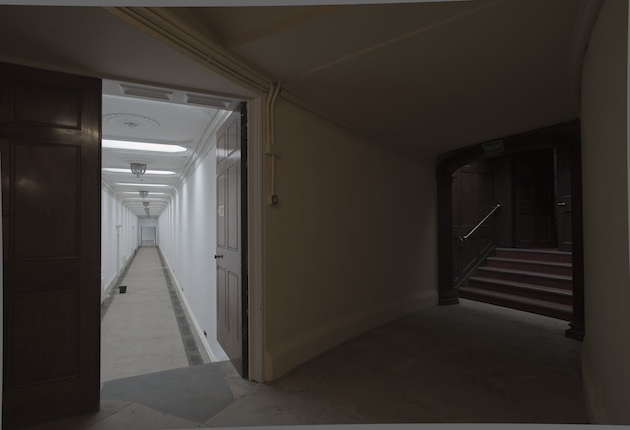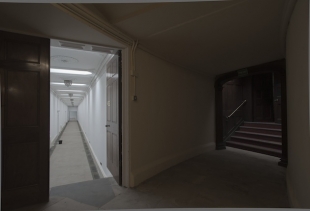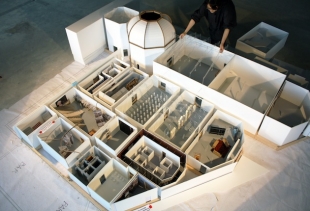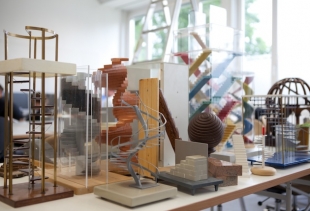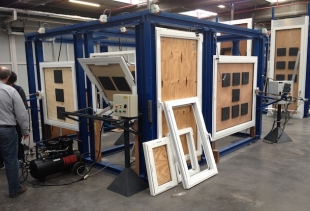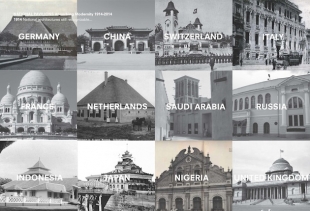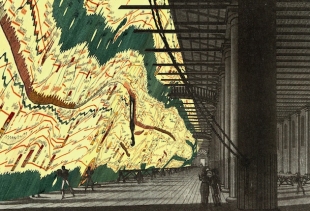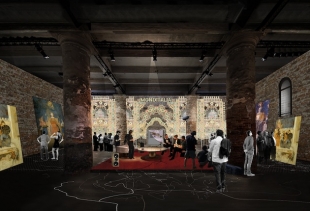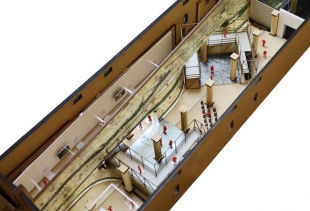» archive blog
-
Carnal, issue 0 of Parterre de Rois
A new magazine in Milandate: 18-07-2013
-
Interview with Nicola Toffolini
A worlds inventordate: 24-04-2011
-
Donne senza uomini.
Installazione multimediale di Shirin Neshatdate: 01-03-2011
Architecture steps back to Fundamentals and, in a sense, to cabaret: this is the Koolhas' Biennale
Why we do not like (completely) this Biennial
I did not like very much the Venice Architecture Biennale 2014. Why? Because, in some extent, I saw it as a blunt pencil in spite of the premises of a brilliant show (a research based exhibition, a true space for cultural production and for a knowledge based approach, the first attempt to rebrand the other festivals we’ve reviewed – Dance, Music, Theatre).
Let’s progress one piece by the other: the Koolhas’ show (Fundamentals) is deploying, as usual, in the Gardens (Central Pavilion) and at the Arsenale. When you enter in the Gardens sections, it seems to you to enter a book of architecture and of history with selected sections dedicated to treatises on “hardware” such as stairs, doors, elevators (there is no lack of experimentation, as the Eindhoven Polytechnic one that I did not understand as it was exhibited)…A central living room connects all the units (that are as many as the volumes of the gigantic catalogue of the Biennale) with a series of movies, edited to render the exact point in which the scenes depict those same elements of architectures starring in the show.
At Arsenale there is the section Monditalia: a scan, a recognition under the form of a spatial grid, of the Italian peninsula and history (written, filmed, rebuilt by young architects, writers, photographers, researchers and historians who have been in varied ways linked to OMA and AMO). This exhibit can be read in two (complementary) ways: the histories of the architectures, the themes or the currents (among the first, for instance the architecture of religions or a project of AMO and the European Commission about the cultural identity of Europe) run in parallel to a collection of above 80 famous movies directed by incredible stars and on Italy (the screenings are always on but in deputed days all along the exhibition calendar, some proper screenings with audio and bigger projections have been set on).
Monditalia (the exhibit) worked well either on a visual and on a cultural layer even if it has been low budget (each invited architect had a fixed amount of space available and a small contribution he/she had to enlarge with further donorships). From South (including the territories subjected to the Italian Colonialism in Africa) to the North (the best project is Borders, that is beside a stunning movies on Alps, 2011, by Armin Linke: quite often the screening was not working in these months): the reading of Italy, according to Koolhas’ intention, has been necessary more than of other countries because of the nature of experimentation of this nation alongside the abysses!
By reading the selected projects on a more social scale, the perhaps most touching parts of Monditalia are the ones on La Maddalena, Sardinia (a very solitaire craftsman reworks the scrap the sea brings to him; beside architect and Koolhas’ friend Stefano Boeri tells about the failure of an architecture he built for the G8 relocated at L’Aquila), two stories on clubs (one, NightsSwimming, signed by the photographer and publisher Giovanna Silva that is also a book), one on the ephemeral architectures. There are lots of sparks to look again at the very recent Italian history, as a touching pictorial project on L’Aquila earthquake and consequences signed by Andrea Sarti we’ve met just before the Biennial Opening). There is still today (November 23rd) to visit the maybe more involving part of the exhibit (a very incredible work is signed by the Spanish architect we’ve interviewed as well, Andre Jacques, on the TV based urbanism of Silvio Berlusconi, that has been awarded by a Lion).
But Monditalia, if seen as the live cultural palimpsest of the exhibit – has been the most failing part, from a certain point of view. In the Corderie at Arsenale there have been all the stages and theatres the Dutch architect designed to host in these months the other Biennials (curious that if you buy a ticket for the Architecture one, the Dance or Theatre or Music performances of that day are included in yours but it is not valid the contrary for those have bought the other tickets…it is an annexation much more than a rebranding!). We could speak of a series of “obliged” festivals that were not always working: the matter is a design one (some columns were blocking the right view of the performance for many parts of the audience!) but also the quality of some proposals inserted in the “obliged” calendar (as very ugly artists’ movies or very repetitive dance performances).
It is not only the formula and the striking design errors that were not convincing us, because the crucial issue is always to fill the stages with audience (when they have been called to host conferences). The so called Week-end Specials and the other conference panels (that have been the backbone of this Biennale – at least in the declarations of intents before its beginning) were often empty or not well crowded especially from those kind of audience (as students) that has been clearly not detected and/or encouraged. The curator’s staff, beside to have not designed a win-win promotion strategy for such an ambitious cultural program, was either not issuing a price policy able to increment (but also segment) the presences for the sole talks.
I think is not fair to create such a performative architecture biennale without size well the problems – as the limits of the institutions, of the place, of what the city expresses in terms of interest and of marketing difficulties.
The National Pavilions have been unified for the first time by a theme the curator proposed (Absorbing Modernity 1914-2014) and have been for sure the best episode of this Biennale (it is useful to remember that Koolhas asked and obtained the double of the time to prepare it than the other curators before him).
For many reason it is impossible to say which pavilion has been the most interesting because each of them expressed the genius loci and its own way to modernity. Two pointing dissertations on interiors have been issued – respectively – by Spain and Belgium. The first is curated by Inaki Abalos (who signs also other projects at Monditalia, always with the crucial support of Accion Cultural Espanola): selected architectures have been depicted with extra-large spatialized – and in a way three-dimensional - pictures of their interiors. The second is a research over five years on how the public housing inhabitants personalize these modernist and very conformed architectures (a very well done book complements the exhibit): the continuity or the fractures are transferred from the book to the pavilion architecture where chairs, kitchen furniture, bookshelves populate and prop up the half void pavilion.
The Netherlands, the country of the curator, faces the theme with a monograph of a very seminal designer for the modernism in its country (and for the development of public housing), Jaap Bakema.
Austria works on the concepts of power and democracy with an exhibition on parliaments (varied are the contributions on this theme also in Monditalia) dialoguing with the restoration of the pavilion garden that has been also activatd by a very well done sound installation (among the designers in this pavilion: Coop Himmelblau, Auböck und Kárász, Kollektiv / Rauschen group - this latter for the sound design).
United States have maybe better interpreted the theme and found (given the limits of the structure) the best way to offer an event roster all along the Biennale (conferences, meetings, screenings, design of cocktails and of scents…).
Entering the U.S. Pavilion at the Venice Architecture Biennale (OfficeUS), you find a rationalist building permeated by a paradox: it has been set out as a “performing” library and a contradictive repository. It hosts the grammar of the power and its counterpart: the new generation of practitioners who constantly erode its role or play camouflage with it. The library contains the modernist architectures built abroad by US architects in the interval 1914-2014. Besides wandering throughout and consulting the selected projects (that are displayed privileging a keen, somehow extreme aesthetics in terms of graphics, usability, keyword navigation and spatial comfort leading the audience to stay as much as possible in the exhibition space), you can feel yourself “activated” without heavy requests in a working space where students, performers and many guests interact on a daily basis. The sketch-board of OfficeUS however starts before, within its website, where you can find the agenda, all the research documents, live streaming and the possibility to organise hangouts with them, the consistence of the library and all the possible tools (including a site-specific soundtrack going on 24/7). Then you can decide how to join them, when and for what purpose. Every day is different in this non-space.
What you do not miss is that this is the temple of US representational, political and economical power vis-à-vis other nations and states. The very refined exhibition and program (that has been ashamedly not awarded with a Silver Lion or a Golden Lion) has been conceived with a very low budget and by lots of donors thanks to a very active New York based non-profit architectural and arts space Storefront, curator of the pavilion. I met two of the six very young partners taking on their shoulders the practical realization of this amazing way to speak and make visible what moves architecture and urban design: privileges dressed up sometimes by democracy, sometimes by modernism, sometimes by private initiative with costing public effects.
The two partners are Alon Schwabe and Daniel Fernández Pascual. They are also forming their own performance arts practice called Cooking Sections. This interview has to be a double sip, possibly switching from one to the other.
For those of you loosing the Architecture Biennale in Venice, there is a good web repository of interviews and videos at the Biennale Media Center.

